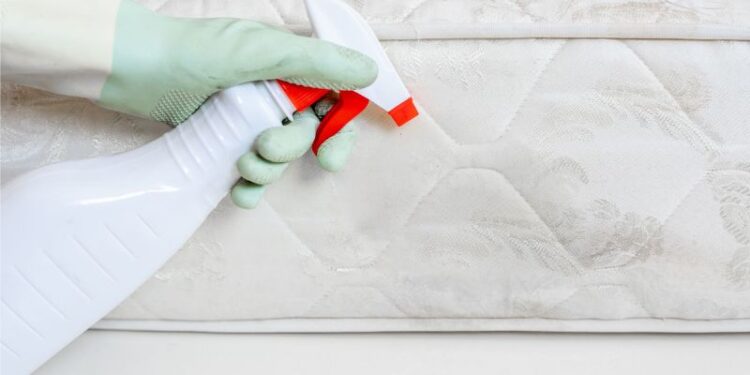Mold and mildew can be persistent problems, especially when they start to affect items in our homes, such as mattresses. Not only can mold and mildew cause unpleasant odors, but they can also pose health risks. It is important to address this issue promptly to ensure a clean and healthy sleeping environment. In this article, we will explore effective methods to remove mold or mildew from a mattress in 2023. With the help of practical bullet points, you will learn step-by-step how to tackle this problem and restore your mattress to its former glory.
How to Remove Mold or Mildew From a Mattress in 2023?
To remove mold or mildew from a mattress, follow these steps:
Safety First
-
- Before starting the cleaning process, ensure proper ventilation in the room by opening windows or using fans.
- Wear protective gloves, a face mask, and eye goggles to avoid direct contact with mold spores.
- Remove any bedding and wash it separately using hot water and detergent.
Preparation
-
- Place the mattress in a well-ventilated area, preferably outdoors or in a room with good air circulation.
- Vacuum the surface of the mattress thoroughly to remove loose mold spores and debris.
- Dispose of the vacuum bag immediately to prevent the spread of mold.
Natural Remedies
-
- Vinegar Solution:
- Mix equal parts of white vinegar and water in a spray bottle.
- Spray the solution generously over the mold or mildew-affected areas of the mattress.
- Allow the vinegar solution to sit for approximately one hour.
- Blot the area with a clean cloth or sponge to remove excess moisture and mold.
- Let the mattress air dry completely before covering it with fresh bedding.
- Baking Soda:
- Sprinkle a generous amount of baking soda over the moldy areas of the mattress.
- Gently rub the baking soda into the fabric using a soft brush.
- Leave the baking soda on the mattress for several hours or overnight.
- Vacuum the mattress again to remove the baking soda residue.
- Vinegar Solution:
Commercial Cleaners
-
- Hydrogen Peroxide:
- Check if the mattress manufacturer recommends using hydrogen peroxide.
- Dilute hydrogen peroxide with water (follow the instructions on the bottle).
- Apply the mixture to the affected areas and let it sit for approximately 15 minutes.
- Blot the mattress with a clean cloth or sponge to remove the solution.
- Allow the mattress to air dry completely before putting on clean bedding.
- Enzyme Cleaners:
- Choose an enzyme-based cleaner specifically designed to eliminate mold and mildew.
- Follow the instructions provided by the manufacturer for proper application.
- Apply the cleaner to the affected areas and allow it to penetrate the fabric.
- Wipe away the excess cleaner and let the mattress dry completely.
- Hydrogen Peroxide:
Sunlight and Fresh Air
-
- Sunlight and fresh air are natural remedies that can help eliminate mold and mildew.
- If weather permits, place the mattress outdoors in direct sunlight for several hours.
- Ensure that both sides of the mattress are exposed to the sun.
- Allow the mattress to air out and dry completely.
Preventive Measures
-
- Use a mattress protector or encasement to create a barrier against mold and mildew.
- Ensure proper ventilation in your bedroom by opening windows or using a dehumidifier.
- Regularly clean and vacuum your mattress to remove dust, dirt, and potential allergens.
- Keep the bedroom humidity levels below 50% to discourage mold growth.
- Rotate and flip your mattress periodically to promote even wear and discourage moisture buildup.
FAQs (Frequently Asked Questions)
Q: Can mold or mildew on a mattress cause health problems?
A: Yes, mold or mildew on a mattress can cause respiratory issues, allergies, and other health problems, especially for individuals with sensitivities or pre-existing conditions.
Q: How often should I clean my mattress to prevent mold or mildew growth?
A: It is recommended to clean your mattress at least twice a year. However, if you notice any signs of mold or mildew, you should address the issue promptly.
Q: Can I use bleach to remove mold or mildew from a mattress?
A: While bleach can be effective in killing mold, it is not recommended for use on mattresses as it can damage the fabric and potentially cause discoloration.
Q: Can I save a mattress with extensive mold or mildew damage?
A: In severe cases where mold or mildew has extensively damaged a mattress, it may be challenging to salvage it. It is often best to consult with a professional cleaner or consider replacing the mattress.
Q: Are there any natural ways to prevent mold or mildew growth on a mattress?
A: Yes, you can prevent mold or mildew growth on a mattress by ensuring proper ventilation, using a mattress protector, and keeping the bedroom humidity levels low.
Q: Can I sleep on a mattress after cleaning off mold or mildew?
A: Once you have thoroughly cleaned the mattress and allowed it to dry completely, it should be safe to sleep on. However, it is always recommended to follow the manufacturer’s instructions and consult with a professional if needed.
Conclusion
Mold and mildew on a mattress can be a cause for concern, but with the right approach, it is possible to remove them effectively. By following the steps outlined in this article and taking preventive measures, you can maintain a clean and healthy sleeping environment. Remember to address mold or mildew issues promptly to prevent further damage and potential health risks. Rest easy knowing that you have the knowledge and tools to keep your mattress fresh and mold-free.

